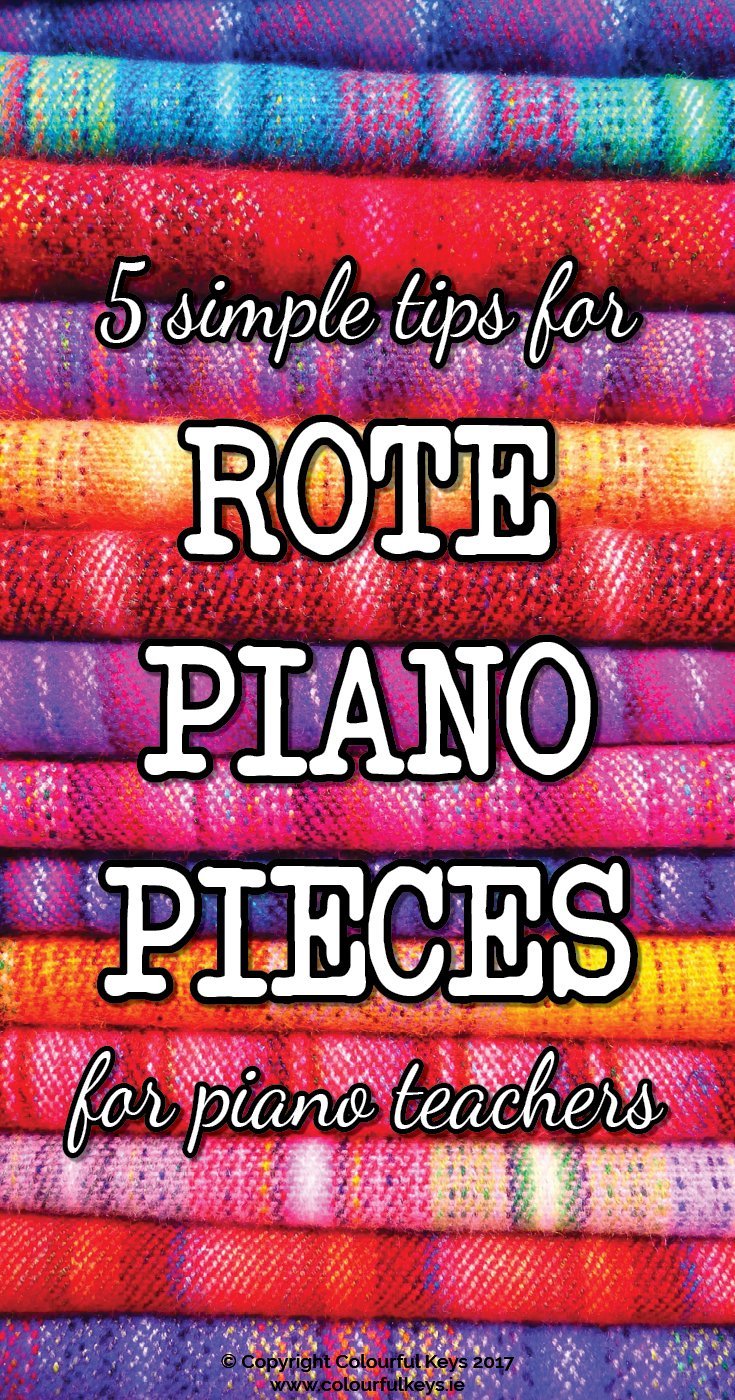Even experienced teachers can be nervous of rote teaching if they’ve never done it before. The book sitting on the stand in front of you is a comforting point of reference, a roadmap not just for the playing but sometimes for the teaching too.

I was certainly apprehensive the first few times I did rote teaching. I can’t even play that well from memory myself – how am I going to teach kids to do it?!
But rote teaching really isn’t anything like memorising pieces in the way you might have done it before. At least I consider them completely different skills.
I like how Piano Safari describes their rote pieces now as “pattern pieces”. Whatever you call them though, it’s all about easy to play but hard to read pieces.
These pieces are extremely motivating for beginners because they can make big full sounds in the first few lessons.
I highly encourage you to give rote teaching a try – and I’m going to talk you through it. No need to be nervous when you’ve got these five tips in mind.
1. Don’t Talk Too Much
It’s tempting when you first start rote teaching to over-explain the patterns and the format. Don’t do it.
Let words be your last resort not your first.

Instead first try demonstrating in smaller and smaller chunks. If that doesn’t work sing along and guide with your voice while your student plays. And if that doesn’t work give simple reminders like: “This is the bit that goes up, remember?”
2. Notice the Common Pitfalls
You won’t know the common pitfalls in the pieces when you first start teaching them, but do keep mental notes as you go.
For example, in Charlie Chipmunk (at the beginning of Piano Safari) students often forget the different ending when the second phrase is repeated.
So I now make a special point of this and we both sing along with the words: “It’s the end!” at that part.
Little things like this are what make your rote teaching processes smoother and smoother each time. Just be patient with yourself and don’t expect to predict every pitfall right out of the gate.
3. Ask Questions
This goes right along with the don’t talk too much advice above.
In rote teaching, as in all teaching, it’s better to have a student discover than to actually tell them. So help them along in their discovery with lots of questions.

Before I play a rote piece for the first time for my student, I always tell them what I’m going to ask about.
“After I play this I’m going to ask you about the louds and softs, and the rhythm. Pay special attention to the patterns in my left hand and tell me what you notice.”
Then, when I’m done playing, I ask. If they can’t answer any of the questions I’ll play it again – but I don’t expect them to get everything on the first listening either.
Continue asking questions right the way through the rote teaching process as you deal with the different sections and chunks of the piece.
- What was the next bit?
- How many times did I play that in total?
- What’s happening in the story here?
- What are the words for that part?
The more questions you get her to ask herself, the better your student will know the piece.
4. Use Crutches Liberally
Yup. I really mean it.
You don’t have written music to refer to, so use every other tool and “crutch” in your toolkit.
Some of my favourite rote teaching assists include:
- Singing along as the student plays
- Pointing to the keys from above
- Playing the same thing in a different octave
- Saying the rhythm syllables
- Playing one hand while she plays the other
- Bringing for a “ride” with her hand placed on top of mine as I play
- Playing as a team with me guiding her hands through the piece
Use any and every tool that will help your student play.
Don’t worry about letting her do things independently in the beginning. Whenever she’s struggling, come up with a way to make it easier.
5. Repeat, repeat, repeat
Not in one go. Repeat the rote piece throughout the lesson.
The more times you get your student to recall the information, the stronger her memory of it will be. It really is that simple.

In the beginning stages I like to cycle through all the rote pieces we’re working on (could be one, could be three at a time) at least four times during the lesson.
So there’s the initial teaching stage, and then at least three more opportunities to practice remembering the piece during the lesson time – all broken up by other activities and pieces.
Are you nervous of rote teaching?
I hope I can encourage you to give it a try. It really is so much fun and so rewarding!
If you have more questions about getting started with rote teaching – please leave them in the comments below.


I have been reading and listening a lot about pattern and rote teaching. I really want to try it but am unsure where to start. Do you have a few recommendations for method books? I know Piano Safari is one. Are there others you recommend? What about for students who have been taking lessons for a while and can already read? How can I add this in to their lessons? I really see the need because once they get to a certain point in their regular lesson books, it seems like it’s a struggle for them to learn longer pieces. I am always pointing out patterns in their pieces and trying to approach them in creative ways, but I want them to be able to come to it on their own as well as be able to read more at a faster rate. I know that recognizing patterns helps their sightreading. Thanks for this article!
Hi Gigi! I would recommend you start with Piano Safari because they have the best resources to help you the teacher to get started. Just buy Pattern Pieces 1 (a supplement not a method book) as an experiment and see how you get on with it – you’ll be hooked soon I’m sure!
I start a lot of transfer students on some rote work when they get to me because it helps them see patterns (as you say), they can focus more on the technique because they’re not reading, and they learn to trust their memory and have fun leaping across the keys! 🙂
Hello! I am just starting out teaching by rote and am using Piano Safari. Absolutely love it! Do you only teach students one rote piece at a time? Is it confusing for them to learn multiple at the same time if you’re splitting them up in the lesson? I am mainly referring to the beginner level. I have several students in Piano Safari level 1 and the majority of the pieces are by rote. Wondering if I should introduce more than one song in a lesson.
You can definitely do more than one rote piece in a lesson. Just make sure you’re teaching each in small chunks and using the name of the piece often so students can organise them in their head.
Btw, Piano Safari is not majority rote. That’s only true in the intro unit.